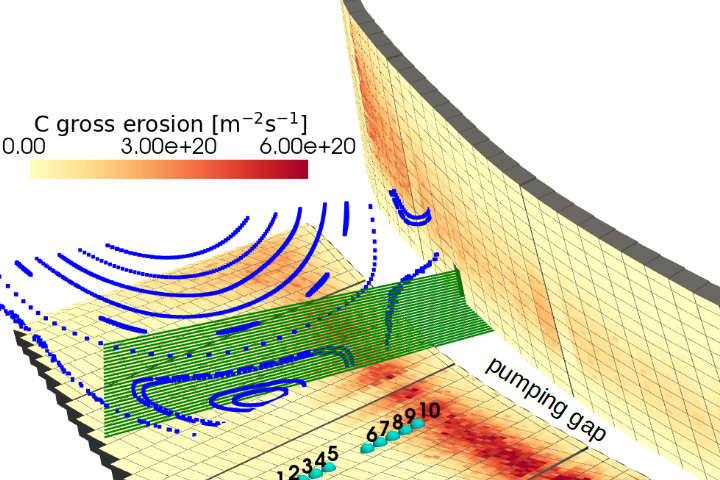At EUROfusion, we are proud to highlight the remarkable contributions of Dr. Juri Romazanov to the field of plasma-wall interaction (PWI), a critical challenge in the development of fusion power via Magnetic Fusion Energy (MFE). This week’s featured image showcases an ERO2.0 simulation of the Wendelstein 7-X divertor, with graphite as the plasma-facing material.
The development of a prototype fusion power plant hinges on addressing several crucial PWI-related issues.:
- Wall Erosion: Caused by energetic particles, known as physical sputtering, must be minimized to extend the life of plasma-facing components and prevent harmful dust production.
- Fuel Retention: Managing fuel retention through implantation and co-deposition is essential for an efficient tritium cycle.
- Impurity Transport: Preventing the transport of heavy impurities into the core plasma is necessary to avoid dilution and radiative cooling, which could significantly reduce fusion power output or even cause plasma shutdown.
Dr. Romazanov developed the 3D Monte Carlo code ERO2.0 specifically to tackle these challenges. This advanced code calculates material erosion and redeposition patterns along the reactor wall and the distribution of impurities in the plasma. Experimental verification is crucial for reliable predictions, and Dr. Romazanov has compared synthetic diagnostic data from simulations with experimental data from devices such as the JET tokamak and the W7-X stellarator. This includes spectroscopic measurements of impurity line emission and post-mortem analysis of erosion and deposition on the wall.


Since my PhD, I have helped establish a junior research group working with ERO2.0 and developing the code to improve its physical model. Our improvements include considering additional physical processes in the transport or using better input data for the sputtering coefficients. Scientists from the European and international fusion research community are increasingly using ERO2.0 to analyse their experiments. This has led to many fruitful international collaborations, and ERO2.0 is now widely accepted as a state-of-the-art tool in its field. Today, it is applied to various existing tokamak and stellarator experiments such as W7-X, WEST, LHD, EAST, and KSTAR, and it is also used for predicting plasma-wall interactions in ITER and the European DEMO reactor.
– Dr. Juri Romazanov
